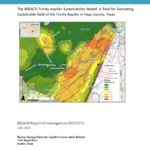The BSEACD Trinity Aquifer Sustainability Model: A Tool for Evaluating Sustainable Yield of the Trinity Aquifer in Hays County, Texas
 Report: View
Report: View
Topic: Sustainable Yield, Groundwater Modeling, and DFCs
Source: BSEACD
Format: Report of Investigations
Year: 2023
View the executive summary here.
The Trinity Aquifer in Hays County is an important groundwater resource which is the only available source of drinking water to people living in central and western Hays County, and is the source of ecologically, culturally, and economically important springs within the Blanco River Basin. Pumping has increased in recent years as a result of rapid population growth, putting increasing strain on this critical groundwater resource. Numerical groundwater models are a useful tool for simulating impacts of different pumping and/or recharge conditions, and thus are a valuable tool for guiding the groundwater planning process. This report documents development of the Trinity Aquifer Sustainability model (TAS), a transient numerical groundwater model developed by the Barton Springs/Edwards Aquifer Conservation District to guide development of a policy framework for sustainable management of the Trinity.
The TAS utilizes MODFLOW USG, a modular finite-difference flow model, for simulating hydraulic head (water level) and springflow in the Trinity Aquifer. The conceptual model for the TAS consists of the three hydrostratigraphic units in the Middle Trinity Aquifer (from top to bottom): the Lower Glen Rose, Hensel, and Cow Creek. Regional groundwater flow is generally from west to east over the study area. Springs discharge from the Middle Trinity Aquifer as artesian springs within the Blanco River basin upstream of the Balcones Fault Zone, including Pleasant Valley Spring and Jacobs Well Spring, and as gravity-fed seeps and small springs along some reaches of the Pedernales River. Recharge enters the model in portions of the Blanco River and Onion Creek Basins. Pumping is represented as both discreet (non-exempt) pumping wells and as distributed, non-discreet polygons (exempt). Faults associated with the Balcones Fault Zone displace hydrostratigraphic units downward from west to east, and act as barriers to lateral groundwater flow.
The TAS was calibrated over a 13-year transient simulation period from 2008-2020 using a combination of manual parameter adjustments and automatic calibration using the PEST software package. Head calibration targets consisted of water level measurements from monitoring wells throughout the study area with 4128 observations. Springflow calibration targets consisted of a combination of manual springflow measurements and monthly-averaged continuous USGS flow gage measurements. Sensitivity analyses for specific model parameters were performed to evaluate the impact of individual parameter uncertainties on overall model performance. Horizontal hydraulic conductivity, general head boundary head elevation, and recharge were determined to be the most sensitive of the parameters evaluated for impacting head calibration statistics. Storage parameters had minimal sensitivity to calibration statistics.
Predictive models were constructed from the calibrated TAS model to evaluate the impact of different pumping and drought scenarios on aquifer water levels and spring discharge. These predictive models indicate that increases in pumping across the study area have the potential to result in significant decreases in water levels and significant reductions in springflow. Predictive scenarios approximating the 1950’s drought of record show that drought also has an important impact on water levels and springflow, especially when coupled with increased pumping. These predictive model scenarios, and others planned for future development, will be a valuable tool for guiding Trinity Aquifer groundwater management policymaking for the Barton Springs/Edwards Aquifer Conservation District.






